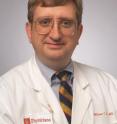Breakthrough breast cancer therapy reduces mastectomies, saves breast
A new treatment developed and tested by University of Oklahoma researchers not only killed large breast cancer tumors, but reduced the need for mastectomies by almost 90 percent. The latest results appear in an upcoming issue of the Annals of Surgical Oncology. Building on this success, researchers at the OU Health Sciences Center, plan to start the next phase of clinical trials this year to test the therapy on even larger tumors.
"This therapy is a major advancement for women with later stage breast cancer. Right now, most patients with large tumors lose their breast. With this treatment along with chemotherapy, we were able to kill the cancer and save the breast tissue," said William Dooley, M.D., a researcher at the OU Cancer Institute and the director of surgical oncology at OU Medicine.
Dr. Dooley is leading a group of researchers from OU, the Massachusetts Institute of Technology, the Los Angeles Biomedical Research Institute, the Comprehensive Breast Center in Florida and St. Joseph's Hospital in California.
They are working on a treatment called Focused Microwave Thermotherapy. The technique, which was approved by the U.S. Food and Drug Administration, uses a modified version of the microwave technology behind the "Star Wars" defense system.
In the most recent study, researchers tested the therapy on tumors that were an inch to an inch and a half in size. These large tumors usually require mastectomies. When researchers used the heating therapy within two hours of patients receiving chemotherapy, the tumor was more susceptible to the chemotherapy and shrunk rapidly. The percentage of patients needing mastectomies was reduced from 75 percent to 7 percent.
"The trial was very successful. We were able to completely reverse those odds," Dooley said. "We redesigned the machine and will begin clinical trials this year to determine whether the therapy works on tumors that are larger than one and a half inches and smaller than 5 inches in size."
In theory, Dooley said the technique could be used on any organ that could be "held relatively still." Scientists are now working to integrate heat-sensitive nanotechnology that would more precisely target cancer cells. They also plan to study a byproduct of the rapid disintegration of the tumor – a boosted immune system. Dooley said it looks like the rapid release of cancer proteins into the blood stream is causing an immune response that could reduce the chance of cancer recurrence.
Source: University of Oklahoma
Articles on the same topic
- Genes found linked to breast cancer drug resistance could guide future treatment choicesSun, 24 Jan 2010, 18:38:41 UTC
- Cell of origin identified for common type of breast cancerTue, 19 Jan 2010, 17:32:33 UTC
Other sources
- Genes linked to breast cancer drug resistancefrom Harvard ScienceMon, 25 Jan 2010, 17:42:40 UTC
- Genes found linked to breast cancer drug resistance could guide future treatment choicesfrom Science DailySun, 24 Jan 2010, 23:21:15 UTC
- Genes found linked to breast cancer drug resistance could guide future treatment choicesfrom Science BlogSun, 24 Jan 2010, 19:21:16 UTC
- Genes found linked to breast cancer drug resistance could guide future treatment choicesfrom PhysorgSun, 24 Jan 2010, 18:14:25 UTC
- Breast-feeding rates tied to white women's body mass indexfrom LA Times - HealthSat, 23 Jan 2010, 11:28:15 UTC
- Environmental Cues Lead to Breast Cancerfrom Science DailyFri, 22 Jan 2010, 6:22:00 UTC
- Breakthrough breast cancer therapy reduces mastectomies, saves breastfrom Science DailyTue, 19 Jan 2010, 17:28:15 UTC
- Breakthrough breast cancer therapy reduces mastectomies, saves breastfrom Science BlogTue, 19 Jan 2010, 15:36:02 UTC
- Breakthrough breast cancer therapy reduces mastectomies, saves breastfrom PhysorgTue, 19 Jan 2010, 15:14:31 UTC
